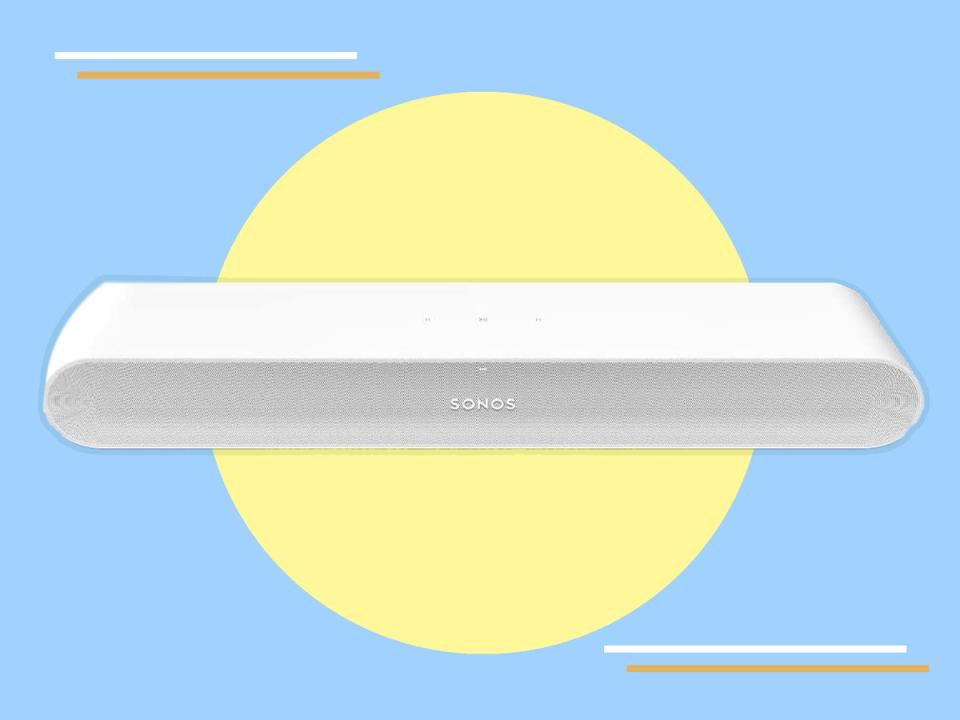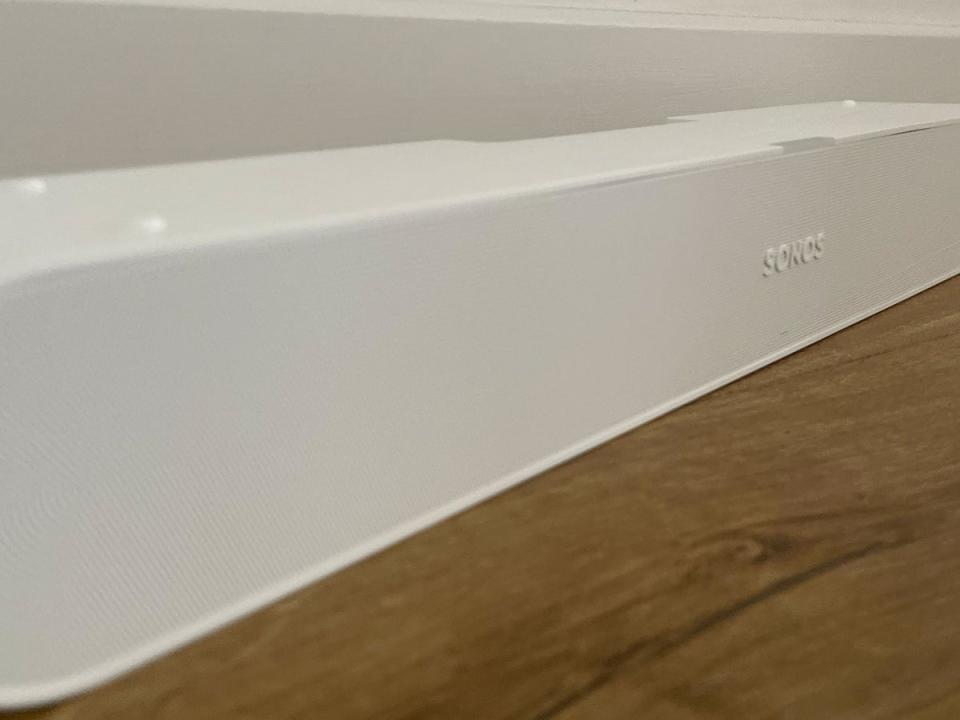Sonos ray soundbar review: Exceptionally affordable but a little frustrating

Sonos speakers are some of the best in the business, with each one looking sleek, refined and handsomely polished, wherever they sit in the house. Boasting mind-blowing, room-filling sound, Sonos soundbars have gained a market-leading reputation over the years, but that’s easy to do when you’re a premium brand.
We can wax lyrical about the Sonos beam gen 2 (£425, Amazon.co.uk) and the beefy Sonos arc (£839, Amazon.co.uk), but they’re both luxury products.
For years now, the company has let brands like Denon and JBL lounge around in the entry-level market, but with the Sonos ray soundbar (£279, Sonos.com), the company is hoping to muscle its way in with an affordable option of its own.
While it’s unlikely that the Sonos ray is going to be competing with the beam or the arc or, really, any Sonos soundbar that has come before it, we wanted to find out whether this could be the new go-to for those first getting into the game. Equally, we wanted to see if this was really a viable option for those wanting to boost the sound of their TV without needing the over-indulgent explosive theatrics of Dolby Atmos.
While there surely must have been some corner-cutting, some give or take that made the Sonos ray less immersive, less of a premium product, just like every other entry-level soundbar, Sonos isn’t really positioning it as such. From the marketing spiel, this is the soundbar to enhance your telly experience, whether that’s streaming content or next-gen gaming. So, with that in mind, is it worth a spot in your home? We put it to the test.
Read more:
How we tested
We hooked up the Sonos ray to our 65in entry-level Samsung TV and watched a range of different TV shows and films from both streaming services and terrestrial TV in order to get a full sense of the depth, scale and weight of the sound. Ultimately, we wanted to see if the Sonos ray improved audio on our TV, seeing as our current TV speakers aren’t really up to scratch.
We also listened to a host of music genres, testing the bass, mid-range and the treble, determining its overall sonic quality. And we also looked at how easy the ray was to set up, control and connect, as well as evaluating the soundbar’s design and its features.
Sonos ray: £279, Sonos.com

Rating: 7/10
Dimensions: H:7.1cm x W:55.9cm x D:9.5cm
Weight: 1.95kg
Speakers: two tweeters, two midwoofers
Connections: Optical, ethernet, wifi, AirPlay 2, Spotify Connect
Sound formats: Dolby Digital, DTS Surround, Stereo PCM
Voice assistant? No
Separate subwoofer included? Not included, sold separately
Design
If you thought the Sonos beam gen 2 (£449, Sonos.com) was a petite machine, take a look at the Sonos ray, which is really as small as it gets. It borrows the same sleek design of its older siblings, including the Sonos arc (£849, Johnlewis.com), but squashes it all down into a smaller, flatter frame.
So, even though you might have opted for the cheapest in the range, it still looks like you’ve got a premium soundbar sat underneath your telly – although it does look a little disproportionate if you’ve got a TV that’s larger than 55in. This design continuation adds a neat sense of cohesion to Sonos’s whole soundbar line-up.
Featuring a classy polycarbonate grill – that’s right, no fabric covering on this one – it’s a really slick-looking machine, and comes in either white or black. It’s a minimalistic design, with minimalistic controls. You’ve only got three touch-enabled buttons on the top of the speaker for pause, play and volume controls, but you won’t find a microphone button here – the ray isn’t voice-compatible, so there’s no Alexa integration.
Read more: These are the best TV deals for this month on cheap 4K sets from LG, Sony, Samsung and more
Plus, in the back alcove, you’ve got an ethernet port, an optical port and a power outlet. Yep, that’s your lot – no HDMI nor HDMI eARC on the Sonos ray, you have to connect it to your TV using the older optical connection.
While all Sonos soundbars are a doddle to set up, the lack of HDMI compatibility, present on the rest of the Sonos soundbar family, makes the Sonos ray more of a hassle than most. Because it has to be connected via an optical cable, we couldn’t control the volume using our Samsung One smart remote.
Basically, most modern TVs use HDMI-CEC, which lets you control the volume of any HDMI-connected devices using one remote. You don’t have that simplicity when using a device hooked up through the optical port. And because the smaller ray doesn’t have an in-built microphone, you can’t ask Alexa to increase or lower the volume either.
The Sonos ray does work with an infrared remote, so we were able to control the volume with our main Samsung IR remote, but if we didn’t have an infrared-compatible controller (owners of some LG tellies could have issues), we would have had to control the volume using the Sonos app or by tapping the volume controls on top of the soundbar itself. Not ideal, and feels a little archaic given that most soundbars these days are HDMI compatible.

Sonos does have extensive help pages for setting the ray up with specific TVs, but you’ll have to leave aside half an hour or so to get it all connected. The Sonos app does walk you through most of this, and it does try to simplify things as much as possible.
Sound
There’s another issue with an optical connection, and it’s the fact that you’re limited to stereo PCM, Dolby Digital and DTS sound formats, rather than the more cinematic-sounding Dolby Atmos, which creates the illusion of three-dimensional sound. Of course, you can pair a couple of Ikea symfonisk table lamp speakers (£199, Ikea.com) and use them as rear speakers for a surround sound experience, but they’re not cheap. If you splurge on a couple of Symfonisk speakers, you might as well invest in the larger Sonos arc.
That said, it doesn’t seem to matter too much when you’re actually watching a TV show, a film or listening to music. Although it only delivers stereo audio, the Sonos ray sounds brilliant, even if it might not be as room-filling as the Sonos beam or arc.
Read more: 9 best portable projectors for a cinematic experience at home
Despite only having four drivers, Sonos has packed a lot of engineering ingenuity into this thing to make it sound good. There are two midwoofers in the middle and two tweeters which fire out into the custom-designed waveguide, positioned on each end of the soundbar, helping to split the audio both outwards and at the listener. This effectively creates a bit more width in terms of sound.
We initially thought that this would hinder the dialogue rather than enhance it, but we were quickly proven wrong. When watching Netflix’s 6 Underground, dialogue came across crystal clear, separating neatly from the whirring blades of the helicopters in the action scenes.
Dialogue is sometimes difficult to hear in reality TV shows like Love Island, however, but we found that the ray boosted the clarity of people’s speech, making it easier to understand whispered conversations. This was far better than speech clarity on our TV speakers.
While we found that the sound was a little lacking in the bass department, leaving us a little underwhelmed when it came to watching films with heart-pumping soundtracks, we were impressed with how it delivered music over AirPlay. The ray handled mid and low frequencies with poise and muscle, while high frequencies came across clear and concise. If you own the Sonos one speaker (£199, Sonos.com), you’ll notice a lot of similarities in the sound.
Read more: How to sign up for a Now TV membership, the free trials and what to watch
It also gets surprisingly loud for something so small, managing to fill our (albeit tiny) living room with ease. The lack of sonic depth and width is pretty evident, however. You can tell that the sound is much more directional than Sonos’s pricier models – they both feel more enveloping than what you get on the Sonos ray, even after we’d used the Trueplay feature in the app.
But as mentioned previously, this is a soundbar positioned for starter home cinemas, so for the price, this is a splendid-sounding speaker, just don’t expect it to stretch very far or into every corner of the room.
The verdict: Sonos ray soundbar
This is the most affordable soundbar Sonos has ever made, and while there are a few annoyances when it comes to the use of the optical connection, or really, the decision to forego an HDMI connection, the Sonos ray soundbar still sounds epic. It doesn’t sound as good as the beam or arc, which have dedicated channels for surround sound virtualisation, but for those starting out with a home cinema setup, this will amp up the dialogue on the TV, fill your living room with sound and do it without distortion. It’s a great first step for an affordable Sonos soundbar.
Sonos ray
Buy now £279.00, Sonos.com
Voucher codes
For the latest discounts on speakers and other tech offers, try the links below:
Looking for a cheap surround-sound option? Have a look at our round-up of the best budget soundbars

 Yahoo News
Yahoo News 